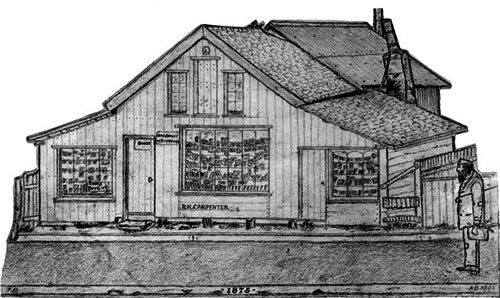-
Laurent commented on New Zealand Maori rugby
-
Ralph Taylor commented on Maungaraki war memorial, Gladstone
-
Jeremy Sutherland commented on South Canterbury rugby
-
Descendant commented on Portrait of Te Rangihaeata
-
Diane Wilkins commented on Camp Waitara painting
The armed Chartist's book shop

Sketch of Robert Carpenter’s bookshop as it appeared in 1875.
The eccentric bookseller
Well-read settlers often complained that colonial New Zealand was a cultural desert, but numerous small public lending libraries, mechanics' institutes and commercial 'circulating' libraries served the voracious demand for books. Wrigglesworth's Circulating Library in Wellington offered 'Upwards of 500 volumes, All standard works'. Chapman's, established in Auckland in 1855, was the largest circulating library in the country, with more than 4000 volumes.
Book shops also helped fill the void. Booklovers in Wellington made a beeline for the 'Old Identity Book Shop' on Molesworth Street in Thorndon, run by the eccentric Robert Holt Carpenter. The English-born radical had reputedly taken part in the great Chartist demonstrations of the late 1830s, when Britain's first mass working-class movement had campaigned for social and political reforms, including universal suffrage. He migrated to Wellington in 1842 and initially found work as a bookbinder.
When he came to public prominence as an advocate for the colonial working class in the early 1850s, Carpenter was labelled 'an armed Chartist' and 'the Wellington Quilp' (after the evil, deformed moneylender Daniel Quilp in Charles Dickens' The Old Curiosity Shop). The voters obviously disagreed: he served as a member of the Wellington Provincial Council (1857-61, 1864-5) and represented the Thorndon ward on the Wellington Town Board (1868-71).
Carpenter established himself as a bookseller in the early 1850s. He traded mainly in second-hand books but also imported and sold new volumes. He claimed that his shop was patronised by 'the cleverest men and prettiest women in the Southern Hemisphere', including the Governor, judges and 'all the leading statesmen'. The renowned bibliophile Sir George Grey was indeed one of Carpenter's most famous customers; undoubtedly the General Assembly librarian was also a regular visitor to the Molesworth Street shop, which was just across the road from Parliament.
The shop contained an extraordinary collection of books, including some rare and valuable volumes that Carpenter always refused to sell. He apparently read his own stock extensively, drawing on his reading to illustrate his political speeches and punctuate everyday conversations. This probably contributed to his growing reputation for eccentricity. Even so, his business prospered enough to allow him to make a small investment in rural land (his wife, Harriet, also supplemented the family income by making fancy waistcoats). By the time he retired, due to paralysis, in the mid-1880s, Carpenter was himself firmly established as one of Wellington's 'old identities'. He died there on 24 February 1891.
Further information
Alexander Turnbull Library, Wellington, New Zealand
Reference: Sketch of Carpenter’s
bookshop as it appeared
in 1875, Wellington
City Council collection,
NON-ATL-0174
Permission of the Alexander Turnbull Library, National Library
of New Zealand, Te Puna Mātauranga o Aotearoa, must be obtained before any
re-use of this image


 Delicious
Delicious StumbleUpon
StumbleUpon Facebook
Facebook Twitter
Twitter Google
Google







Community contributions